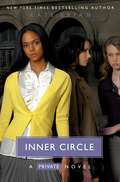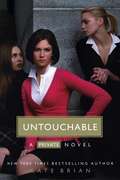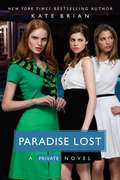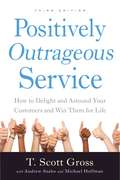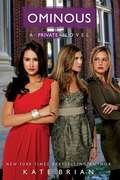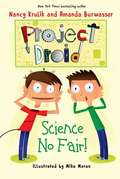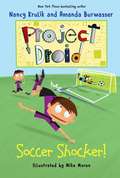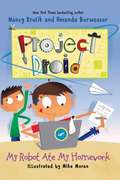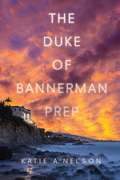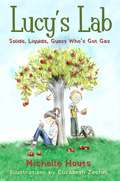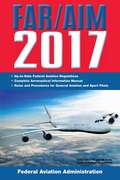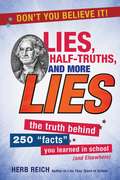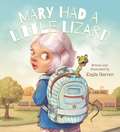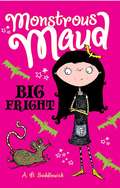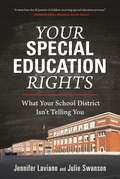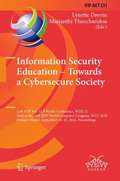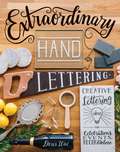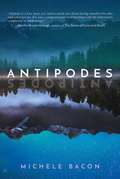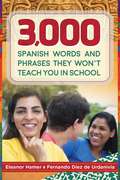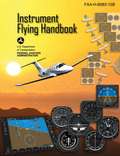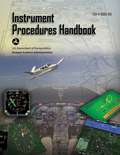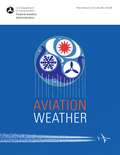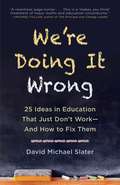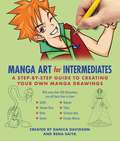- Table View
- List View
Inner Circle: A Private Novel
by Kate Brian Julian PeploeReed Brennan arrived at Easton Academy expecting to find an idyllic private school experience -- challenging classes, adorably preppy boys, and a chance to create a new life for herself. Instead, she discovered lies, deception, blackmail, and...murder. But, thankfully, the killers were caught and the nightmare is finally over. Now, with a new school year ahead of her, Reed steps back on Easton's ivy-covered campus ready to start over. So when the headmaster announces that billings is forbidden from holding their traditional, secretive initiation, Reed is relieved. She champions the new rules and the six new girls the administration has picked to live in Billings Hall: Constance, Missy, Lorna, Kiki, Astrid, and newcomer Sabine. But Reed's fellow Billings resident and new nemesis, Cheyenne Martin, believes the changes are a mockery of Billings history. Despite the new rules, Cheyenne vows to keep the old ways alive, no matter what -- or who -- stands in her way...
Untouchable (Private Series #3)
by Kate Brian Julian PeploeCheating, partying, blackmail, and now...murder? Can the Billings Girls remain untouchable? Reed's boyfriend, Thomas Pearson -- the popular, easygoing, irresistibly handsome and charismatic boy she fell in love with -- is dead. No one knows how it happened, and everyone is after the truth. Or are they? Life at Easton Academy begins to feel very different. Taylor is acting like the poster child for Prozac, Kiran is spiking her cornflakes, Noelle is being kind of...nice, and Arianna keeps floating along as if nothing has happened. Thanksgiving break arrives and Reed and Josh find themselves alone on campus. They are forced to confront the feelings they've been hiding. Those feelings combined with an empty campus result in the hottest hookup Reed could possibly imagine. But when Reed breaks the news about Josh to the Billings Girls, there's no fun game of tell-all. Instead, Josh begins to look like suspect No. 1 in the murder of Thomas Pearson. The perfect life Reed has constructed as a Billings Girl begins to crumble. And as everyone becomes more convinced of Josh's guilt, Reed's private suspicions lead her somewhere she doesn't want to go.
Paradise Lost (Private Series #9)
by Kate Brian Julian Peploe Andrea C. UvaParadise awaits.... Now that Cheyenne's murderer has been revealed and Reed knows the truth about who's been stalking her, she's ready to leave the heartache and turmoil of last semester behind. And what better way to recover than a five-star Caribbean vacation? Reed is reunited with former Billings Girls Kiran and Taylor, and she and her friends take over the exclusive island. They spend their days tanning on white-sand beaches and their nights partying on sixty-foot yachts. It's heaven on earth. But as they raise their champagne flutes to toast their friendship, Reed worries that it's all too good to be true. Because even in paradise, the Billings Girls are never far from trouble -- and nothing's more dangerous than the calm before the storm....
Positively Outrageous Service: How to Delight and Astound Your Customers and Win Them for Life
by T. Scott GrossIn today’s tough economy, cutting prices and providing good service aren’t enough. To be truly successful, innovative businesspeople must learn the art of Positively Outrageous Service (POS)-doing the unexpected unexpectedly and giving the customer more than he or she could hope for. POS put customer service guru T. Scott Gross on the map in the early 1990s. In this revised third edition, he contemporizes his work by examining what’s wrong in the service industry today and how to turn those negatives into POS. In his signature, slightly irreverent, but always insightful style, he shows managers at every level of the service industry how to:Build a customer base by following the four key principles of promotions-have fun, get people to your store, get people involved with your product, and do something good for othersHire the right people and show them the fundamentals of POSEnergize and obtain the most creativity out of employeesWin over customers when mistakes happen, no matter who is at faultPOS is not just a way of doing business, according to Gross; it’s also a state of mind and the key to success in the twenty-first century. T. Scott Gross is a consumer advocate whose client roster for consulting, training, and speaking reads like a who’s who of the Fortune 500. Countless businesses, including Southwest Airlines, FedEx, McDonald’s, Sears, and Wal-Mart, have asked him to motivate the troops at sales meetings and conferences worldwide.Allworth Press, an imprint of Skyhorse Publishing, publishes a broad range of books on the visual and performing arts, with emphasis on the business of art. Our titles cover subjects such as graphic design, theater, branding, fine art, photography, interior design, writing, acting, film, how to start careers, business and legal forms, business practices, and more. While we don't aspire to publish a New York Times bestseller or a national bestseller, we are deeply committed to quality books that help creative professionals succeed and thrive. We often publish in areas overlooked by other publishers and welcome the author whose expertise can help our audience of readers.
Ominous (Private Series #13)
by Kate BrianAfter the shocking revelations made in the Private prequel, The Book of Spells, Noelle and Reed know they are descendants of the original Billings Girls and their legacy includes a mysterious coven of witches. But it's nothing compared to what happens next. One by one, Billings Girls go missing from campus. The entire community bands together to find the lost girls, hoping they are still alive. Reed can't believe tragedy has struck Easton again, and she begins to wonder if the Billings Girls are cursed. But when the first body shows up containing a message just for her, she fears her friends are worse than cursed: they're doomed. The penultimate book in the suspenseful Private series!
Science No Fair!: Project Droid #1 (Project Droid)
by Nancy Krulik Amanda Burwasser Mike MoranHilarious story about a slightly crazy science and engineering experimentLogan Applebaum tries to keep his new robot cousin, Java, a secretLogan’s science fair rivals steal Java, and Logan worries they’ll discover Java’s true identity If you thought your science fair experience was nerve-wracking, try being Logan Applebaum. One day, his inventor mother declares that she made a new robot cousin for Logan, Java. Java might be incredibly bright, but he’ll also be quite the handful. Logan had a picture of how the third grade would go. Java was not part of that picture. As the third grade science fair gets closer and the kids prepare for their experiments, Logan thinks Java will come in handy. He can at least help Logan beat the Silverspoon twins, who always win everything. Unfortunately for Logan, the twins Sherry and Jerry steal Java as their partner. Even worse, these kids become suspicious. Can Logan work quickly enough to keep a crazy experiment from becoming a crazier disaster? Join mother-daughter author duo Nancy Krulik and Amanda Burwasser as they introduce the comedic pair of Logan and Java. This first installment of their Project Droid #1 story reminds readers of Amelia Bedelia with a delightful modern edge. Science No Fair! is an excellent pre- bedtime book choice.
Soccer Shocker!: Project Droid #2 (Project Droid)
by Nancy Krulik Amanda Burwasser Mike MoranWhen Mom tells Logan that Java is joining his soccer team, the Purple Wombats, he’s not thrilled. It’s a lot of work teaching his new robot cousin how to act like a human-and keeping him out of trouble-and Logan needs a break.Still, being programmed for success means that Java’s also great at scoring. He might just turn the Wombats into a championship team, beating Sherry and Jerry Silverspoon and their Red Polar Bears . . . if he’d just let the other kids play, too. After being replaced as the Wombats’ MVP, Logan’s had enough.But when Java gets wet and goes on the fritz, can the whole team-even a short-circuiting Java-come together to score the winning goal?The second in a fantastically funny new chapter book series by internationally bestselling author Nancy Krulik and her daughter, Amanda Burwasser, Soccer Shocker is destined to win tons of fans.Sky Pony Press, with our Good Books, Racehorse and Arcade imprints, is proud to publish a broad range of books for young readers-picture books for small children, chapter books, books for middle grade readers, and novels for young adults. Our list includes bestsellers for children who love to play Minecraft; stories told with LEGO bricks; books that teach lessons about tolerance, patience, and the environment, and much more. While not every title we publish becomes a New York Times bestseller or a national bestseller, we are committed to books on subjects that are sometimes overlooked and to authors whose work might not otherwise find a home.
My Robot Ate My Homework: Project Droid #3 (Project Droid)
by Nancy Krulik Amanda Burwasser Mike MoranLogan better study up on his geography facts so he doesn’t flunk out!Third-grader Logan Applebaum has the perfect solution to finding time for all that pesky homework—just have his cousin, Java, do it for him. With a robot cousin, Logan’s pretty much guaranteed straight As.But when Mrs. Perriwinkle announces that the class will have a geography bee, Logan realizes that if he doesn’t want to be exposed as a cheater, he’s going to have to hit the books and fill his own hard drive with facts.The competition’s going to be tough. And the more time he spends studying, the more he wants to show what he’s learned. Can Logan out-smart the mega mean Silverspoon twins who win at everything and a cousin who’s a super computer to come out on top as the geography king?Internationally bestselling author Nancy Krulik and her incredibly talented daughter, Amanda Burwasser spin hilarious high jinks in the third book in the Project Droid series, which combines the literalness of Amelia Bedelia with a wacky modern edge, making for hours of laughter. And the fun continues with an activity in the back!
The Duke of Bannerman Prep
by Katie A. NelsonWords are weapons. Facts can be manipulated. And nothing is absolute-especially right and wrong.Tanner McKay is at Bannerman Prep for one reason: to win. The elite school recruited him after he argued his public school's debate team to victory last year, and now Bannerman wants that championship trophy. Debate is Tanner's life-his ticket out of scrimping and saving and family drama, straight to a scholarship to Stanford and a new, better future.When he's paired with the prep school playboy everyone calls the Duke, Tanner's straightforward plans seem as if they're going off the rails. The Duke is Bannerman royalty, beloved for his laissez-faire attitude, crazy parties, and the strings he so easily pulls. And a total no-show when it comes to putting in the work to win.As Tanner gets sucked into the Duke’s flashy world, the thrill of the high life and the adrenaline of the edge becomes addictive. A small favor here and there seems like nothing in exchange for getting everything he ever dreamed of.But the Duke’s castle is built on shady, shaky secrets, and the walls are about to topple.A contemporary retelling of The Great Gatsby, Katie A. Nelson’s taut debut is perfect for anyone who's struggled to survive the cutthroat world of competitive high school.
Solids, Liquids, Guess Who's Got Gas?: Lucy's Lab #2 (Lucy?s Lab)
by Michelle Houts Elizabeth ZechelAutumn has arrived, and at Granite City Elementary School everyone is gearing up for the biggest and best event of the year: the Harvest Festival. The whole school is excited about the games, the contests, the food, and, most of all, the costumes! Everyone except Lucy. She doesn’t like dressing up, and has no desire to be a fairy princess or rock star, even for one day. But Lucy is excited about the new science unit Miss Flippo has started: the states of matter. Lucy and her friends understand solids and liquids. They’re easy. But gasses are more difficult to grasp. When the class goes on a field trip to an orchard and Stewart Swinefest eats too many apples, and gets a serious stomachache, Lucy suddenly understands that even if you can’t see gasses they can fill space and expand, and even make you move. And with Stewart feeling better, she has a really great idea for her Harvest Festival costume, too.The second book in a new chapter book series from IRA Children’s Book Award-winner, Michelle Houts, Solids, Liquids, Guess Who’s Got Gas draws on STEM themes and is aligned with curriculum guidelines to bring a love of science to young readers, inspiring them to start their own labs and explore their world.
FAR/AIM 2017: Federal Aviation Regulations / Aeronautical Information Manual (Far/aim Ser.)
by Federal Aviation AdministrationLearn to fly a plane according to Federal Aviation Administration (FAA) regulationsThe most complete guide to the rules of aviation accessible anywhere Contains all of the information needed to operate safely in US airspace and is fully updatedIf you are an aviation enthusiast or an aviator, you need to have the newest edition of the FAR/AIM. In the most recent edition of the FAR/AIM, produced by the FAA, all procedures, illustrations, and regulations are up-to-date and reflect current FAA data. Learn about takeoffs and landings, land navigation, how to aid climb, world flight patterns, flying rolls, academic liftoff, and more. This useful reference book is a critical resource for all members of the aviation community, including aspiring pilots seeking a concrete background in the rules, procedures, and requirements of flight training. This manual also includes: A study guide for specific pilot training certifications and ratingsStandard instrument proceduresA pilot/controller glossaryParachute operationsThe NASA Aviation Safety reporting formAirworthiness standards for products and partsImportant FAA contact information
Lies, Half-Truths, and More Lies: The Truth Behind 250 "Facts" You Learned in School (and Elsewhere)
by Herb W. ReichHistory is replete with stories of great people and extraordinary events that either never happened or didn’t happen the way we were told they did. Such news or embellishment thereof are part of what we consider common knowledge – information taught in schools and passed down to us. And they are wrong. How about these gems:The winter of 1777-78 was the coldest winter in Valley Forge in years, and many Continental soldiers died from the sub-zero weather: LIEMohandas Gandhi held a lifelong belief in nonviolence, that characterized the struggle for Indian independence: LIEThe atomic bombings of Hiroshima and Nagasaki were the mostr destructive air strikes against Japan during World War II: LIELies, Lies, and More Lies is a humorous, witty, and charming collection of anecdotes surrounding history, pop culture, and more. It is a book that will have readers questioning what they’ve learned or been told and, for these 250 facts anyway, the book advises you: Don’t You Believe It!
Mary Had a Little Lizard
by Kayla HarrenA modern take on “Mary Had a Little Lamb” featuring hilarious antics as Lizard sneaks into Mary’s backpack and causes nothing but mayhem in her Kindergarten class. He eats someone’s lunch, makes a mess in the painting corner, and scares the teacher silly during story time before being sent to the principal’s office to wait for Mary's mom to pick him up. It’s no fun being alone. But when Mary finally comes home from school, Lizard knows he’ll always have his very best friend.Rendered in a combination of traditional and digital color, Mary Had a Little Lizard is a silly, satisfying celebration of new experiences and friendships that can never be broken.
Monstrous Maud: Big Fright (Monstrous Maud Ser. #1)
by A. B. SaddlewickWhen Maud’s pet rat, Quentin, escapes in the middle of science class, it’s the very last straw. While Primrose Towers is full of decorous young ladies, Maud is ungraceful and prefers her pet rat to all other company She never quite fit in with the rest of the students and has been a nuisance one too many times. Maud is transferred from prim and proper Primrose Towers to dark and mysterious Rotwood Middle School—much to the delight of her teacher, classmates, and her perfect twin, Milly—but what is in store for Maud at Rotwood? There is something strange about the students and teachers. Everyone is dressed as if it’s Halloween and the school motto is “Because We Scare.” Maud learns two very important things on her first day at Rotwood: first, all of the students and teachers are monsters and second, she’s finally found a place where she feels like she belongs. While Primrose Academy rejected Maud’s differences, Rotwood allows her to embrace them. Even though she’s not a monster, Maud must make everyone believe she is in order to stay at Rotwood with her new friends. Monstrous Maud: Big Fright is a great alternative to princess books for middle grade readers. It is full of silliness and monster fun—along with likeable characters and a great twist at the end.
Your Special Education Rights: What Your School District Isn't Telling You
by Jennifer Laviano Julie SwansonDrawing on decades of experience, Jennifer Laviano, a high-profile special education attorney, and Julie Swanson, a sought-after special education advocate, help parents of students with disabilities navigate their school systems to get the services they need for their children.Parents will find no other book on special education like Your Special Education Rights. Julie and Jennifer demystify the federal laws that govern the rights of public school children with disabilities and explain how school districts often ignore or circumvent these laws. They pull the curtain back on the politics of special education, exposing truths that school districts don’t want you to know, such as the fact that teachers are often under extraordinary pressure not to spend resources on services.Most importantly, they outline the central rights you and your child have regarding your child’s education. Did you know that you can refer your child for a special education evaluation? That you can ask for a second opinion if you disagree with the results of some or all of the testing? That you are entitled to parent counseling, training, and more?They also show you how to take that knowledge and apply it to advocating for your child. Here’s what you need to know about the paperwork you will have to complete, detailed information on how to advocate for your child and how to craft language in documents that benefit your child, and more.Filled with vital information and invaluable resources, Your Special Education Rights gives you the information you need to help your child succeed in school and beyond.
Information Security Education – Towards a Cybersecure Society: 11th IFIP WG 11.8 World Conference, WISE 11, Held at the 24th IFIP World Computer Congress, WCC 2018, Poznan, Poland, September 18–20, 2018, Proceedings (IFIP Advances in Information and Communication Technology #531)
by Marianthi Theocharidou Lynette DrevinThis book constitutes the refereed proceedings of the 11th IFIP WG 11.8 World Conference on Information Security Education, WISE 11, held at the 24th IFIP World Computer Congress, WCC 2018, in Poznan, Poland, in September 2018.The 11 revised papers presented were carefully reviewed and selected from 25 submissions. They focus on cybersecurity and are organized in the following topical sections: information security learning techniques; information security training and awareness; and information security courses and curricula.
Extraordinary Hand Lettering: Creative Lettering Ideas for Celebrations, Events, Decor, & More
by Doris WaiAre you a curious hand lettering beginner or long-time enthusiast looking to take your craft to the next level? Or are you a DIY guru or event planner wishing to breathe new life into a boring gift, event signage, or party décor? Extraordinary Hand Lettering opens your eyes to the endless possibilities in the world of creative lettering, showing you how to work with types of surfaces, such as wood, glass and acrylic, chalk, and even mirrors. First, learn the simple tools and tricks of hand lettering essentials—cursive and basic typefaces, creating balance and composition, and how to draw letters, as well as secret tips on what words you should choose to spotlight or shadow. Then, discover the lettering potentials of everyday items by transforming household objects or discarded items, such as old vintage mirrors, jewelry, and furniture, into a customized gift, unique decoration, quirky art piece, or stunning signage—all with the right lettering and choice of pen, pencil, or marker. For all DIY art-and-crafters, homemakers, and small business entrepreneurs, lettering is a versatile and necessary skill that can repurpose the old into something that is new, beautiful, and functional. Finally, draw inspirations from twelve whimsical projects suited for the girlie girl, the sophisticated man, or the modern minimalist. Combine the art of lettering and upcycling crafts to bring beauty into your everyday lifestyle.
Antipodes
by Michele BaconWhen Erin Cerise steps off her plane in Christchurch, New Zealand, she’s determined to overcome her losses of swim team captainship, her boyfriend Ben, and her reputation. Her mother is certain studying abroad will regain Erin’s chances of a good future. Once Erin meets her uninspiring host family and city, though, she’s not so sure.Before Christchurch, Erin wasn’t always intense and focused. When had her priorities gone upside down?Now, Erin balks at NZ’s itchy school uniforms, its cold houses, and her hosts’ utter inability to pronounce her name correctly. Christchurch does boast amazing rock climbing, gorgeous scenery, and at least one guy who could make her journey worthwhile—if she lets him.With months ahead of her, Erin slowly begins to draw on the years behind her, one step back into her memories at a time. As she rebuilds herself from the other side of the world, she finds that although her life has been turned upside down and she’s far from home, every way she moves takes her closer to where she came from.
3,000 Spanish Words and Phrases They Won't Teach You in School
by Eleanor Hamer Fernando Díez UrdaniviaNo matter how much Spanish you study, it’s nearly impossible to fully convince the native-speakers that you’ve got it. Even those estudiantes perfectos who have seemingly mastered speaking a foreign language in a classroom run into problems in real-life situations. 3,000 Spanish Words and Phrases They Won’t Teach You in School goes beyond classroom Spanish by thoroughly explaining expressions, idioms, and quirks used daily by native speakers. This must-have manual also includes information on pronunciation, manners, abbreviations, and culture, making it much more than a phrase book! Learn within these pages everything you need to know to speak colloquial Spanish, including: Translation of common proverbs: like When in Rome, do as the Romans do.Slang: Like ¡Alivianate!— cheer up or get highDual words: like integro and entero—with the same meaning.False cognates: Words that are similar but have very different meanings in English and Spanish So next time you plan a trip or just want to impress your friends, pick up 3,000 Spanish Words and Phrases They Won’t Teach You in School and drop the stuffy high school phrase book!
Instrument Flying Handbook (Federal Aviation Administration): FAA-H-8083-15B
by Federal Aviation AdministrationThis is the FAA's primary pilot resource for instrument flight rules and training. It (IFR) covers everything pertinent to operating an aircraft, both in instrument meteorological conditions (IMC) and without reference to outside visuals, relying solely on the information gleaned from the cockpit. Information applies to both analog and electronic flight displays, and is organized into separate coverage of the traditional and pictorial displays.Instrument Flying Handbook includes chapters on national airspace system, the air traffic control system, human factors, aerodynamics, flight instruments, flight maneuvers for IFR operations, navigation, emergency operations, as well as helicopter operations and more. Advanced systems are covered, including flight management systems, the primary flight display (PFD) and multi-function display (MFD), synthetic vision, and traffic advisory systems. Instrument clearance shorthand is discussed, and an instrument training lesson guide is provided.The Instrument Flying Handbook is designed for use by flight instructors, pilots preparing for the Instrument Rating FAA Knowledge and Practical Exams, and instrument-rated pilots looking for a refresher or preparing for an Instrument Proficiency Check (IPC). This edition features with full-color illustrations and diagrams, along with a comprehensive glossary and index.
Instrument Procedures Handbook: FAA-H-8083-16A (FAA Handbooks Ser.)
by Federal Aviation AdministrationThis is the new 2015 edition of the FAA's previous "Instrument Procedures Handbook" (previously the FAA-H-8083-16).This book covers all of the information needed to operate safely within the airspace system. In the FAA's "Instrument Procedures Handbook" (#FAA-H-8083-16A) the emphasis is placed on operations and procedural information for real-world use, which makes this the next logical step for pilots after learning basic instrument skills from the FAA's "Instrument Flying Handbook" (#FAA-H-8083-15B). Using this book, pilots can more directly apply the concepts to their current flying situation, and learn how their acquired skills are best used in today’s IFR environment. Considered industry-wide as a top source for instrument procedures information and a "must read” for all instrument pilots, this new 2015 edition brings pilots the latest changes to procedures and even more insights and guidance on how to operate safely within the national airspace system. Detailed information is provided for every navigation receiver and phase of flight on the required precision necessary to stay within protected airspace and to make a successful approach.While it was designed as a reference for professional pilots, the specialized glossary, index, full-color illustrations and photographs in this book make it a valuable training aid for flight instructors, instrument pilots, and instrument students alike. Each topic covered is well-detailed and explained in user-friendly terms, along with full-color depictions to aid understanding.Instrument flight instructors, pilots, and students will need this resource since it is used as a reference for the Airline Transport Pilot and Instrument Knowledge Tests and for the Practical Test Standards. Whether a pilot is a seasoned professional or recently completed an Instrument Rating course, this FAA handbook is sure to encourage more precise instrument techniques and ultimately create a safer pilot.
Aviation Weather: FAA Advisory Circular (AC) 00-6B (FAA Handbooks Ser.)
by Federal Aviation AdministrationAviation Weather is a comprehensive resource for everything that pilots, students, and instructors need to know about navigating all types of weather safely. This book covers both visual (VMC) and instrument (IMC) meteorological conditions, and does so using detailed illustrations and diagrams. Subjects covered include the earth’s atmosphere, temperatures, atmospheric pressure and altimetry, wind, moisture, precipitation, clouds, air masses and fronts, turbulence, icing, thunderstorms, common IFR producers, high altitude weather, arctic and tropical weather, and soaring weather. A detailed glossary and index are provided for guidance.
We're Doing It Wrong: 25 Ideas in Education That Just Don't Work—And How to Fix Them
by David Michael SlaterAn unapologetic critique of major flaws in the American education system. David Michael Slater’s We’re Doing It Wrong is a thought-provoking dissection of the issues plaguing American public schools. Each chapter identifies a major problem in the education system, exploring its roots and repercussions. A teacher himself, Slater opens up and gives readers an insider’s perspective on topics that have been at the center of ongoing debates as well as recent hot button issues, such as: • Standardized testing • Teacher evaluation practices • Helicopter parents • Class size • Poverty’s effect on performance • Anti-bullying programs • Writing proficiency • Curriculum goals Slater explains why our current approaches simply aren’t working—for students, for teachers, for the colleges that these students may eventually attend, and for society at-large. Unafraid to ruffle a few feathers, We’re Doing It Wrong highlights defects in policy and theory, calls out administration, and questions long-held beliefs. Every chapter concludes with a suggestion for improvement, offering light at the end of the tunnel. Administrators, teachers, and concerned parents will come away with a better understanding of the current state of education and ideas for moving toward progress—for themselves and for the students they support.
The New Email Revolution: Save Time, Make Money, and Write Emails People Actually Want to Read!
by Robert W. BlyPractices, strategies, and templates for optimizing your email use. The average business employee spends more than thirteen hours a week reading and responding to email. That’s 675 or more hours—over 28 days a year—spent on email. Wouldn’t it be nice to get some of that time back? In The New Email Revolution, Robert W. Bly Bly draws from decades of experience sending millions of emails to help you take that time back. With this book in hand, you will be able to quickly and easily: •Find templates you can use to create emails for dozens of different situations. •Know the right wording and optimal word length for email communication. •Get recipients to read and respond to your email messages. •Understand when it is legal and not legal to send email to a person you do not know. •Incorporate photos, graphics, sound, and video into your email messages. •Measure the deliverability, bounce rate, open rate, and response rate to every email you send. •Write clearer, more engaging, more persuasive email copy for every occasion. Get better results in less time with The New Email Revolution.
Manga Art for Intermediates: A Step-by-Step Guide to Creating Your Own Manga Drawings
by Danica Davidson Rena SaiyaBring your own manga characters to life! With millions of fans around the world, manga is a beloved art form. Now you, too, can learn how to draw your favorite characters from Japanese comics and anime! Manga Art for Intermediates shows you how to draw detailed clothing, facial expressions, and other features, like hair and accessories. With gradual steps and helpful tips, this book will have you creating your own colorful characters in no time at all! Learn to draw: Gothic Lolita Shonen Hero Bride Groom Nekojin ("cat people") Yokai Victorian Man Female Warrior The authors have done all the work for you. Just follow their simple, straightforward instructions, study the step-by-step drawings, and you'll soon have your own collection of fantastic manga characters!
